Troubleshooting & Information
For issues not covered in the following topics, contact our CM/ECF Helpdesk.
Accessing Recordings of Hearings
Accessing Recordings of Hearings
The following docket entry indicates that an audio recording of a hearing is available to download:

To access an audio file
- Open the PDF document by clicking on the document number.
- Click the attachments (paper clip) icon on the left side of the application. The panel will expand. Double click the mp3 file to open it in your media player.
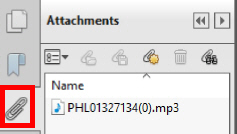
If you do not see the attachments icon:
In Adobe Acrobat:
Click View > Show/Hide > Navigation Panes > Attachments:

In Acrobat Reader:
Click the Adobe symbol in the floating menu at the bottom of the page:

The Attachments icon will appear on the left side of the page.
Adding a new party to a case
Adding a new party to a case
1. Click Add/Create New Party.
2. Enter the last name or the business name of the party in the Last/Business name field and click Search.
3. If the party is not listed in the search results, cick Create New Party, complete all applicable fields, then click Submit.
4. Select the correct party's name then click Select Name from List.
Note: The party name cannot be in ALL CAPITALS, and cannot be longer than 50 characters. If a party displayed in the search results is not available for selection, it is because it is longer than 50 characters so a new party must be created that does not exceed the limit.
Adding a new party to an adversary proceeding
Adding a new party to an adversary proceeding
1. Complete all applicable fields on Plaintiff Information or Defendant Information screen.
2. To add an alias:
- Click Alias.
- Enter Last/ Business name, First Name, Middle Name and Generation.
- Select Role from drop down list (ex. aka, dba, fdba, fka).
- Repeat as necessary.
- Click Add Alias to submit.
3. To add a corporate parent/affiliate:
- Click Corporate Parent / affiliate.
- Complete Business Name search field, click Search.
- Click Create New Corporate Parent / affiliate.
- Select from the drop-down box whether party is a corporate parent or affiliate.
- Click Add Corporate Parent / affiliate.
4. Click Review to verify all party information.
5. Click Return to Party Screen.
Adding hyperlinks to documents
Official Procedure Last Change June 9, 2015
Adding hyperlinks to documents
General information
Parties are allowed, but not required, to use hyperlinks to references contained in papers filed with the Court. If the hyperlink is to a document filed within the ECF system, please use the Linkbuilder function which can be found at https://www.ned.uscourts.gov/internetDocs/cmecf/hyperlinking_attorneys_word.pdf. Use of the hyperlink function within Word can be used for hyperlinks to all other references.
For information on the permissible uses of hyperlinks, please refer to the Court's Guidelines for Use of Hyperlinks in Electronically Filed Documents. More resources on hyperlinking can be found at https://www.ned.uscourts.gov/internetDocs/cmecf/hyperlinking_attorneys_word.pdf.
Addresses of Divisional Offices
Addresses of Divisional Offices
Indianapolis (5-digit part of case number starts with 0-4) :
Room 116 U.S. Courthouse
46 E Ohio St
Indianapolis, IN 46204
Tel: (317) 229-3800
Evansville (5-digit part of case number starts with 7):
352 Federal Bldg
101 NW Martin L. King, Jr. Blvd
Evansville, IN 47708
Tel: (812) 434-6470
Terre Haute (5-digit part of case number starts with 8):
Federal Building
921 Ohio Street
Terre Haute, IN 47807
Note: Documents for Terre Haute cases must be mailed or delivered to the Evansville office. The address shown for Terre Haute is only for hearings and meetings of creditors.
Tel: (812) 434-6470
New Albany (5-digit part of case number starts with 9):
110 U.S. Courthouse
121 W Spring Street
New Albany, IN 47150
Tel: (812) 542-4540
Ballots and voting on Chapter 11 plans
Official Procedure Last Change December 29, 2015
Ballots and voting on Chapter 11 plans
|
How to file: Location of event: Ballots should not be filed with the court. |
|
General information
- Once the court has entered an order approving the Disclosure Statement, the plan proponent must distribute copies of the Plan, Disclosure Statement and ballots, and file a Certificate of Service within 14 days.
- The ballots should not be filed with the court. Creditors should send the ballots to the plan proponent or to the balloting agent if one has been employed, who will tabulate them and file a report with the court.
Filing Requirements
Official Form B314 must be used unless the court has approved variations to that form.
Browse to select a document
Browse (Uploading a PDF file in CM/ECF)
1. Select the main PDF document by clicking the Browse button. This will allow you to browse to where you have the PDF document saved on your computer.
Note: Remember to change the file type to Acrobat (*.pdf).
2. Right-click the PDF document and select Open from the drop-down menu. Adobe Acrobat will open the PDF document so that you can view and verify that it is the correct one for your filing.
3. Close or minimize the Adobe application.
4. Click the Open button. CM/ECF will enter the document name/path in the Filename field.
5. If there are no attachments, leave the Attachments to Document radio button checked No and click Next.
6. If there are attachments, change the Attachments to Document radio button to Yes and click Next.
To add the attachments:
a. Click the Browse button and navigate to where you have the PDF document stored on your computer. Follow steps 2-4.
b. Identify your attached PDF document by either selecting one of the options listed on the Type drop-down menu box or entering a description of the PDF document in the Description box.
c. Click Add to List.
Note: If you inadvertently attach the wrong PDF document, you can click (highlight) the wrong PDF document and click Remove from List.
7. Click the Next button to complete the order upload.
Deleting temporary internet files (clearing the cache)
Official Procedure Last Change January 12, 2011
Deleting temporary internet files (clearing the cache)
In order for information to be displayed properly in ECF it is sometimes necessary to clear the "cache" or temporary internet files that are stored on your PC.
Web browsers store the files needed to display websites that you have visited, which speeds up browsing. However, one side effect is that you may not see updates that are made to CM/ECF unless you delete those temporary files.
You should also clear the temporary files if you are still locked out of ECF after paying all filing fees.
For instructions on how to delete temporary files, see the Help menu on your browser.
Events that cannot be filed on a closed case
Events that cannot be filed on a closed case
Pleadings that set a deadline (or that can set a deadline depending on the circumstances) cannot be filed on a closed case, until a motion to reopen has been filed and granted.
These pleadings are:
| Agreed Consent to Judgment |
| Amended Chapter 12 Trustee's Final Report and Account |
| Amended Chapter 13 Trustee's Final Report and Account |
| Amended/Corrected Petition |
| Answer to Complaint |
| Answer to Counterclaim |
| Answer to Cross-Claim |
| Answer to Third-Party Complaint |
| Appellant Designation/Statement of Issues |
| Application for Final Decree |
| Application for Waiver of Chapter 7 Filing Fee |
| Application to Employ |
| Brief |
| Certification of Eligibility for Chapter 12/13 Discharge |
| Chapter 12 Trustee's Final Report and Account |
| Chapter 13 Trustee's Final Report and Account |
| Chapter 7 Trustee's Final Account, Certification of Full Administration, and Application for Discharge |
| Chapter 7 Trustee's Report of No Distribution |
| Corrected Motion for Relief from Stay |
| Corrected Motion to Abandon |
| Counterclaim |
| Cross-Claim |
| Debtor's Temporary Exclusion from Means Test |
| Designation of Record re: Withdrawal of Reference |
| Hearing Exhibit |
| Hearing Notice |
| Involuntary Summons Certificate of Service |
| Motion for Bid Procedures |
| Motion for Entry of Chapter 12/13 Discharge |
| Motion for Leave to Appeal |
| Motion for Relief from Co-Debtor Stay |
| Motion for Relief from Stay |
| Motion for Summary Judgment |
| Motion for Turnover |
| Motion for Withdrawal of Reference |
| Motion Objecting to Discharge |
| Motion to Abandon |
| Motion to Allow Interest, Fees, and Costs |
| Motion to Appear Pro Hac Vice |
| Motion to Approve Loss Mitigation Agreement |
| Motion to Approve Trial Modification Agreement |
| Motion to Assume/Reject |
| Motion to Avoid Judicial Lien |
| Motion to Avoid Lien on Household Goods Pursuant to 11 U.S.C. Sec. 522(f)(1)(B)(i) |
| Motion to Classify Claim(s) Pursuant to Fed.R.Bankr.P. 3013 |
| Motion to Close Chapter 11 Case |
| Motion to Compromise and/or Settle |
| Motion to Consolidate |
| Motion to Convert |
| Motion to Deem Mortgage Current |
| Motion to Direct Loss Mitigation Mediation |
| Motion to Dismiss Case |
| Motion to Dismiss Party |
| Motion to Extend Time to File Complaint |
| Motion to Incur Debt |
| Motion to Modify Plan Post-Confirmation |
| Motion to Modify Secured Debt |
| Motion to Redeem |
| Motion to Sell |
| Motion to Set Budget for Interim Use of Estate Property |
| Motion to Transfer Case |
| Motion to Withdraw Claim |
| Notice of Abandonment with Certificate of Service |
| Notice of Appeal |
| Notice of Default |
| Notice of Dismissal of Adversary Proceeding |
| Notice of Domestic Support Obligation |
| Notice of Extension of Time to File |
| Notice of Hearing on Emergency Motion to Extend/Impose Automatic Stay |
| Notice of Objection to Claim(s) |
| Notice of Omnibus Hearing Schedule |
| Notice of Trustee's Final Report and Applications for Compensation |
| Notice on Motion for Abandonment & Relief from Stay |
| Notice on Motion for Bid Procedures |
| Notice on Motion for Relief from Co-Debtor Stay |
| Notice on Motion for Relief from Stay |
| Notice on Motion for Turnover |
| Notice on Motion to Abandon |
| Notice on Motion to Allow Interest, Fees, and Costs |
| Notice on Motion to Assume/Reject |
| Notice on Motion to Avoid Lien |
| Notice on Motion to Classify Claim(s) |
| Notice on Motion to Compromise and/or Settle |
| Notice on Motion to Deem Mortgage Current |
| Notice on Motion to Direct Loss Mitigation Mediation |
| Notice on Motion to Modify Plan Post-Confirmation |
| Notice on Motion to Redeem |
| Notice on Motion to Sell |
| Notice on Motion to Set Budget for Interim Use of Estate Property |
| Notice on Motion to Withdraw Claim |
| Objection Notice |
| Objection to Claim |
| Omnibus Objection to Claims |
| Release From Active Duty |
| Request for Certification for Direct Appeal to Court of Appeals |
| Response to Motion for Withdrawal of Reference |
| Statement Adjourning Meeting of Creditors |
| Stipulation of Dismissal of Adversary Proceeding |
| Trustee's Notice of Abandonment |
| Trustee's Notice of Continued 341 Meeting of Creditors |
Generating mailing lists and finding e-mail addresses for service of documents
Official Procedure Last Change April 22, 2013
How to generate mailing lists and find e-mail addresses for service of documents
The Court's Administrative Policies require the filing of a Certificate of Service along with all documents as to which service is required. This Certificate must list all mailing addresses and e-mail addresses to which the document concerned was sent. Example of a completed Certificate of Service, prepared using the instructions below.
How to obtain mailing addresses and e-mail addresses of parties on a case
1. Click on Utilities.

2. Click on Mailings.
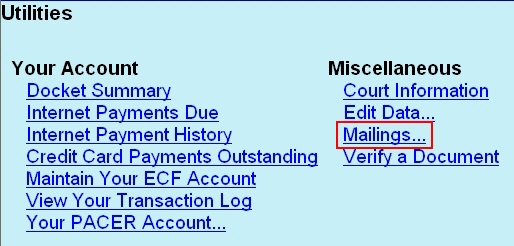
3. Click on Mailing Info for a Case.

4. Enter the case number and click Submit.

5. The screen that next displays contains several parts. First is shown a list of all electronic filers on the case. These are parties that receive notification of everything filed on the case, via e-mail to the e-mail address shown after their name:

These are the parties and e-mail addresses that you would list in the first part of the Certificate of Service, in the section labelled [List parties receiving service electronically with e-mail address].
The next part of the results screen shows the names and addresses of all non-electronic filers who are parties on the case. These are entities who have themselves filed pleadings on the case, but are not registered as electronic filers, therefore are not set up to receive automatic notification of everything filed on the case. The most common example of this type of party is the debtor. Note that the list does not include creditors on the case who have not filed any pleadings other than Proofs of Claim.
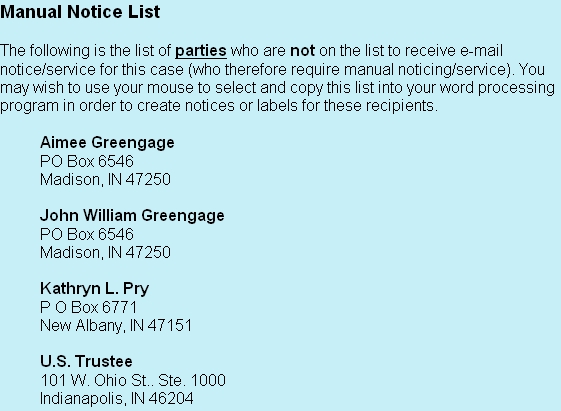
Since these parties do not receive automatic notice of documents filed on the case, any documents required to be served on them must be mailed to them and their names and addresses included in the second part of the Certificate of Service, in the section labelled [List parties receiving traditional service with postal address]. You can easily copy these names and addresses directly from the report shown above and paste them into your Certificate of Service.
What if I also need to serve some or all creditors that are on the case but do not show up on the above mailing information list?
The most effective way to produce a mailing list of creditors, that does not incur a PACER fee, is as follows:
1. Click on Utilities.

2. Click on Mailings.

3. Click on Mailing Matrix by Case.

4. The following option screen is displayed:
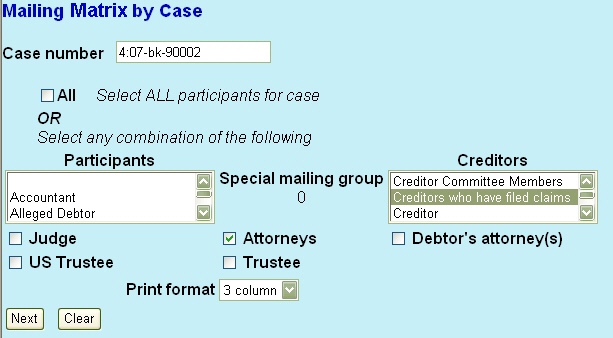
In the Creditors selection list, leave the top blank line selected if you wish to see all creditors. If you wish to pick only certain categories, click on the category to highlight it. To select a second or subsequent category as well, hold down the Ctrl key while clicking on the other category. This selects multiple entries.
Any combination of options can be selected. For instance, the above screen will produce a mailing list for case 07-90002, including only creditors who have filed a claim and attorneys, but not including trustee, judge, US Trustee or Attorney for Debtor.
Choose the options you require and click Next.
The results open as a PDF file containing all selected parties and creditors on the case, which can then be printed directly onto a sheet of mailing labels:
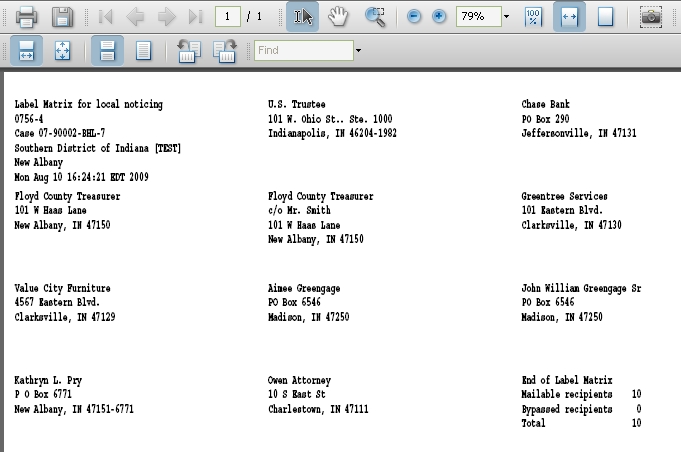
It is formatted to fit a standard sheet of 1-inch labels (30 to a sheet), e.g. Avery 5160 or similar. If the printout does not line up with the labels, you may have to select a different printing option, such as the Fit option shown here:

How to access ECF after being locked out
Official Procedure Last Change April 13, 2022
How to access ECF after being locked out
When an ECF user files a document that requires a filing fee, but fails to pay the fee before the end of the day (11:59:59 p.m. Indianapolis time), the user is denied ECF access for the purposes of filing documents until the fee is paid. A locked-out user will not have access to the Bankruptcy or Adversary menu options, however ECF will allow the user to access the appropriate hyperlinks to pay the outstanding fee.
To pay the outstanding fee
Select Utilities > Internet Fees/Payments > Internet Payments Due
A pop-up window will appear showing all outstanding fees. Scroll down to the bottom of the list and click Pay Now then continue through the On-line Payment Process with your debit card/credit card.
After outstanding fees have been paid, you will need to delete your temporary internet files. After doing so, the user will be unlocked and should have regular access to all features of CM/ECF.
How to find what you need in the Procedures Manual or ECF
How to find what you need in the Procedures Manual or ECF
Searching the Procedures Manual
- Click the Search button on the top of the left-hand panel:
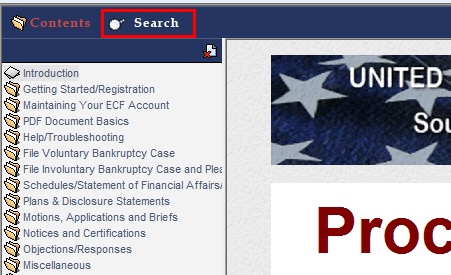
If you do not see the Search button, click the Show link to restore the navigation frame:
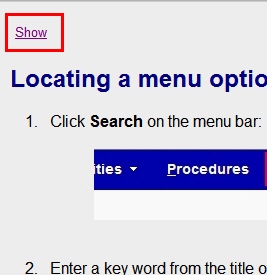
- Enter a search term in the text box and hit Enter (or click the magnifying glass):
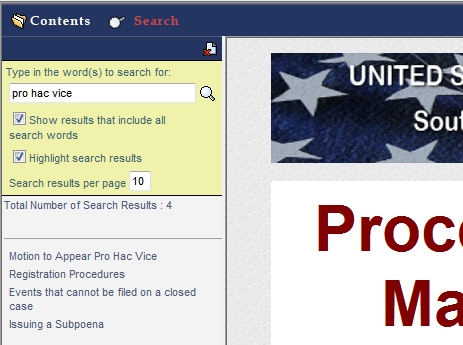
Note that the system will search for the exact expression you entered. If you do not find any results and want to broaden the search, uncheck the Show results that include all search words box.
You can also browse available pages using the Table of Contents by clicking the Contents button to the left of the Search button:
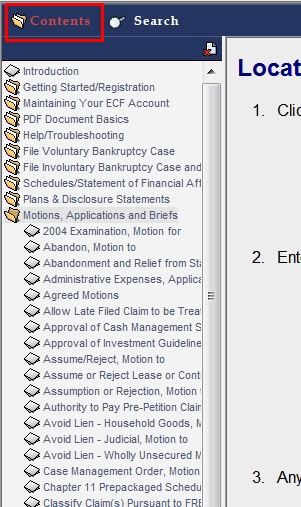
Clicking a category opens it out to display available topics. This can be useful, for instance, to display all available Motion types.
You can also search from within ECF - useful if you already know the name of the type of document ("event") that you wish to file:
- Click Search on the menu bar:

- Enter a key word from the title of your document into the search box and hit enter:
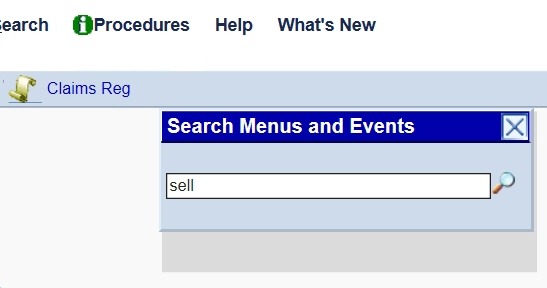
- Any events (menu options) that contain the word you entered are displayed:
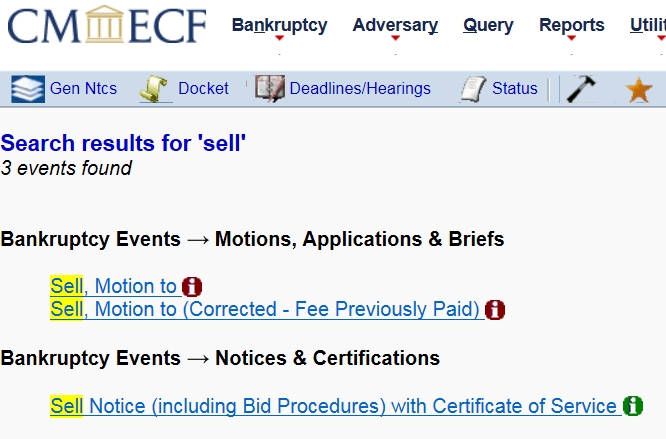
The bold type, e.g. Bankruptcy Events -> Motions, Applications & Briefs is showing in which menu the event displayed can be found. But while you are on this screen, you can simply click the event you want to use and you will be taken straight into the filing of the document.
You can also click the  symbol and be taken directly to the related instructions page in the Procedures Manual. At any time during the filing of the document, the same page can be reached by clicking the
symbol and be taken directly to the related instructions page in the Procedures Manual. At any time during the filing of the document, the same page can be reached by clicking the  Procedures link in the blue CM/ECF bar:
Procedures link in the blue CM/ECF bar:

The  Procedures link is context-sensitive, so will always take you to instructions relating to the ECF screen you are on.
Procedures link is context-sensitive, so will always take you to instructions relating to the ECF screen you are on.
In the example above, it would be incorrect to attempt to file your document using a generic event such as Motion for Authority, since there is an available event for a Motion to Sell.
How to generate a list of cases in which a particular attorney has filed an appearance
Official Procedure Last Change April 11, 2017
How to generate a list of cases in which a particular attorney has filed an appearance
- Click Query:

-
Enter the attorney's name in the Last Name and First Name fields.
-
Select Attorney from the drop-down list, and check the Open cases box:
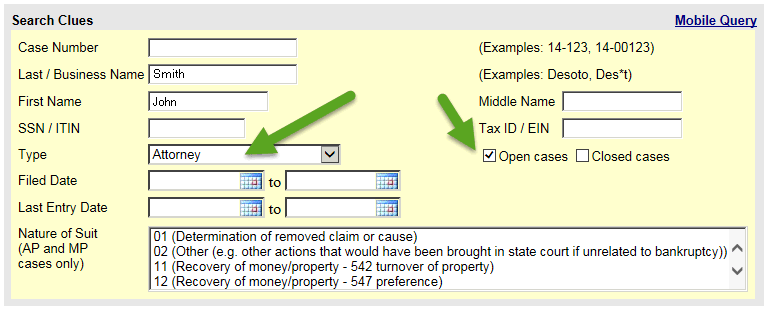
- Click Run Query.
Matters that can be continued
Official Procedure last Change January 14, 2020
Matters that can be continued
The following are the only docket entries to which a Motion to Continue Hearing, Pretrial Conference, or Trial can be related.
- Alias Summons
- Hearing Notice
- Notice - Block Scheduling
- Notice of Hearing
- Notice of Confirmation Hearing Ch 12/13 or Order Setting
- Notice of Hardship Discharge
- Notice of Status Conference re: Confirmation Ch 12 Plan
- Notice of Telephonic Conference
- Objection Notice with Hearing Opportunity
- Official Court Notice Setting Hearing
- Order and Notice for Hearing on Disclosure Statement
- Order and Notice of Telephonic Conference
- Order Approving Disclosure Statement and Scheduling Confirmation Hearing
- Order (Generic) - for instance, Order Continuing Trial
- Order on Motion to Continue Hearing
- Order on Motion to Show Cause
- Order Setting Pretrial Conference
- Scheduling Order
- Summons
Notifications of Electronic Filing
Official Procedure last Change November 15, 2013
Notifications of Electronic Filing
The Notice of Electronic Filing is the verification that the filing has been sent electronically to the Court’s database. It certifies that this is now an official court document, and displays the document number assigned on the docket. Copies of this verification are immediately e-mailed to those able to receive electronic notices on that case.
Who can receive electronic notices?
-
Limited users do not automatically receive electronic notices, except for notices from the court to advise the user of problems in a document he/she has filed (i.e., notices of deficient filing and requests for correction). However, limited users can receive notifications on specific cases by adding those cases to their CM/ECF user account. Show me how
- Even if a limited user files a Request for Notice, this does not result in the user automatically receiving notice of all documents filed. A Request for Notice serves only to get the creditor on the court's mailing list for those documents that get mailed out to all creditors, such as the discharge notice.
- Attorneys automatically receive electronic notices, if all the following are true:
- The attorney is a registered electronic filer, registered as an attorney - not a limited user.
- The attorney has filed a document on the case.
- When filing the document, the attorney checked the following box, if it was displayed:

- Attorneys can also receive notifications on specific cases by adding those cases to their CM/ECF user account, regardless of whether or not the above conditions have been met. Show me how
What is the Notice of Electronic Filing telling me?
-
Clicking on the case number hyperlink will take you to the docket for the case. Note that you will be prompted for your PACER login and password. Users must be registered with the PACER system to have a login and password.
- Clicking the document number hyperlink will open the PDF image of the document just filed. Note that you will be prompted for your PACER login and password.
- Attorney users are entitled to a free look at the PDF. To get your free look, you must click on the document number hyperlink from the Notice of Electronic Filing that you receive via e-mail - not the Notice of Electronic Filing that you see at the conclusion of the filing process. Note that you are only granted one free look, which is only available within the first 15 days. Therefore, you might want to print or save a copy of the PDF.At the bottom of the Notice of Electronic Filing, a list is provided of who did and did not receive electronic notice of the filing.
How to sign up to receive notices for a specific case
Note: Limited users following the instructions below will receive notices of electronic filing but will not be entitled to receive free looks at the PDF files. Limited users must view PDF files via PACER and pay the applicable PACER fees.
After logging in to CM/ECF, click Utilities:

then Maintain Your ECF Account:

then Email information:
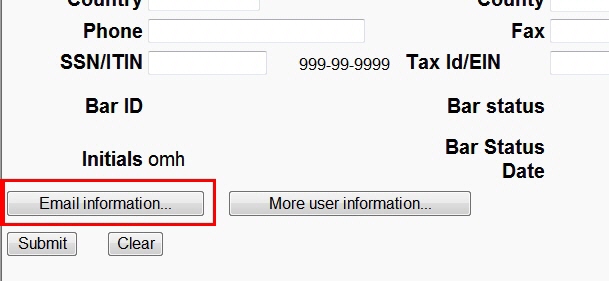
Check the Send notices in these additional cases box. Type the case number for which you wish to receive notices and click Find This Case:

Repeat the process for any other cases for which you wish to receive notices. You can add as many as you want:

Once you are finished entering case numbers, click Return to Account screen:

then click Submit:
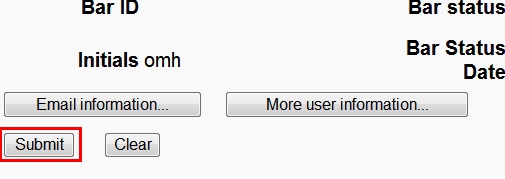
How to receive Adversary notices only; and not related Bankruptcy notices
After logging in to CM/ECF, click Utilities:

then Maintain Your ECF Account:

then Email information:

Select the radio button option which allows notices in the AP only and not the related BK.
Once you are finished entering case numbers, click Return to Account screen:

then click Submit:

Obtaining copies of documents in a case via SmartScan
Official Procedure Last Change July 22, 2016
Obtaining copies of documents in a case via SmartScan
General Information
- Shortly after a case containing paper documents is closed, it is shipped to the National Archives and Records Administration (NARA). Copies of paper documents in cases that have been shipped to the National Archives must be obtained directly from that facility. Note that documents in cases closed fifteen years or more ago may have been destroyed. Contact the National Archives for more information on such cases.
- The SmartScan service is offered by the Federal Records Center (FRC) of NARA, and allows for FRC staff to scan paper documents in their possession, and e-mail them to the requestor via the court as a PDF file. Requests for copies of 100 pages or less can be submitted by this service, which is typically cheaper and faster than obtaining paper copies - requests received early enough in the day are typically processed the same day.
- Requests for copies that exceed 100 pages must be submitted the traditional route for requesting paper copies.
- Copies cannot be provided of cases or documents that are sealed or otherwise restricted.
- The cost of obtaining copies via SmartScan is calculated as follows:
- Retrieval of electronic records from the Federal Record Center fee plus
- Retrieval of electronic records from the Federal Record Center copy costs (per page) fee
To Order Copies via SmartScan
- Contact the appropriate divisional office, which will process the request for you. You will need to provide:
- Your name
- The debtor's Social Security Number, case number, or full name
- Determination of the documents to be copied
- A phone number where you can be contacted once the copies arrive at the court
- An e-mail address to which the copies can be sent (or you can visit the court and provide a flash drive for copying purpose, or receive hard copies for an additional fee)
| Case number format | Divisional Office | Office Phone Number |
|
xx-0xxxx |
Indianapolis | (317) 229-3842 |
| xx-7xxxx | Evansville |
(812) 434-6481 |
| xx-8xxxx | Terre Haute |
(812) 434-6481 |
| xx-9xxxx | New Albany |
(812) 542-4552 |
- Once the copies arrive at the court, you will be contacted and advised of the final cost. You can pay the amount using an approved payment method. As soon as payment is received, the copies can be e-mailed to the address you provided or sent hard copy (note: additional cost will be incurred for hard copies and postage).
Order upload
Upload an Order
Note: All orders must be formatted in accordance with the court's guidelines.
1. If you have just filed a Motion, click the Single Order Upload link displayed on the confirmation screen. Note that the Single Order Upload link is not displayed if a proposed order is not required for the type of motion you have just filed. The court will prepare the order.
Otherwise:
- For bankruptcy cases: Select Bankruptcy > Order Upload > Single Order Upload
- For adversary proceedings or miscellaneous cases: Select Adversary > Order Upload > Single Order Upload
2. Enter case number (in the format xx-xxxxx).
3. Check the box if you are uploading a wage assignment order (do not check the box if you are uploading an amended wage assignment order or an order terminating wage assignment). Click Next.
4. Enter related document number. Click Next (this step is skipped if you indicated in step 2 that you are uploading a wage assignment order).
Notes:
- If you don't know the related document number, click Next, then click Next at the category selection screen (leave all the categories selected). Select the docket entry to which your order relates and click Next.
- If the following message is displayed: Order uploads are not allowed for this event, a proposed order is not required for the type of motion you selected above. The court will prepare the order.
5. Click Next.
Prefix text
Prefix Text
These options are available via a drop-down box during the filing of certain events. If selected, CM/ECF adds them to the final docket text.
Agreed: Select only if the document being filed has been signed by more than one of the following: Debtor/ Debtor’s Attorney, Creditor, Case Trustee. The Agreed prefix text is not required for Stipulations, Immaterial Modifications, or Reaffirmation Agreements.
Amended: Select only if the document being submitted is an amendment to a previously filed document.
Emergency: Typically used with Chapter 11 first-day motions and Motions to Extend/Impose Automatic Stay (if filed more than 10 days after filing of the bankruptcy petition). This text may also be used in other situations. The title of the uploaded document must also include the word Emergency.
Joint: Select if the document is being filed by more than one party.
Reinstated: Select if the document has previously been filed, but was not acted upon by the Court (e.g., because the case was subsequently dismissed but now relief has been granted from the dismissal order).
Retroactive: Select if the motion requests that the relief granted be applied retroactively.
Supplemental: Select only if the document being submitted is a supplement (not an amendment) to a previously filed document.
Preparing redacted documents
Preparing redacted documents
General information
- This procedure is used when preparing documents other than claims for mass redaction, in conjunction with the filing of an Omnibus Motion to Redact Previously Filed Document.
- See separate instructions for preparing redacted claims.
- Should all documents in the docket entry be included?
No, only include the affected PDFs. If the main document includes a personal identifier but the exhibits are fine, only send us the PDF to the main document.
- Is it OK to combine documents?
No, if a docket entry contains several PDFs and each one has a personal identifier, send us a redacted PDF for each document. The program restricts the original document based upon the number provided in the file name. If only one document is provided, only the original document associated with the file name is restricted. The other documents are left unrestricted. In short, never combine documents.
- Should claims and pleadings be separated?
It really does not matter. It is acceptable to include all PDFs in the same zip file.
Step-by-step instructions
- Select Reports > Docket Report.
-
Enter case number of case with pleading to redact and uncheck the Include headers when displaying PDF documents box. Click Run Report.
Note: This step displays claims without a red PDF header and prevents the double stamping of the PDF header once the redacted claim is docketed.
Google Chrome: Disable the Adobe Acrobat extension if the red PDF headers still appear.
- Click the link of the document needing to be redacted. Click the View Document button to view the document.
-
Save the PDF as named in the browser or PDF viewer. The file should always begin with 072, for example, 0721321204094.pdf.
Finishing up
- Edit the PDF and redact the person identifiers found within the document.
-
Repeat the above steps for each document being redacted.
Preparing redacted proofs of claim
Preparing redacted proofs of claim
General information
This procedure is used when preparing claims for mass redaction, in conjunction with the filing of an Omnibus Motion to Redact Previously Filed Document.
See separate instructions for preparing redacted documents other than claims.
- Should all documents in the docket entry be included?
No, only include the affected PDFs. If the main document includes a personal identifier but the exhibits are fine, only send us the PDF to the main document.
- Is it OK to combine documents?
No, if a docket entry contains several PDFs and each one has a specific identifier, send us a redacted PDF for each document. The program restricts the original document based upon the number provided in the file name. If only one document is provided, only the original document associated with the file name is restricted. The other documents are left unrestricted. In short, never combine documents.
- Should claims and pleadings be separated?
It really does not matter. It is acceptable to include all PDFs in the same zip file.
Step-by-step instructions
- Select Utilities > Maintain Your ECF Account.
-
Uncheck the Add Headers to PDF Documents box. Click Submit.
Note: This step displays claims without a red PDF header and prevents the double stamping of the PDF header once the redacted claim is docketed.
Google Chrome: Disable the Adobe Acrobat extension if the red PDF headers still appear.
- Select Reports > Claims Register.
-
Enter case number of case with claim to redact. Click Run Report.
-
Click Next to view Claims Register.
-
Click the link of the claim needing to be redacted. Click the View Document button to view the document.
- Save the PDF as named in the browser or PDF viewer. The file should always begin with 072, for example, 0721321204094.pdf.
Finishing up
- Edit the PDF and redact the person identifiers found within the document.
- Repeat the above steps for each claim being redacted.
Sample Certificate of Service - completed
CERTIFICATE OF SERVICE
I hereby certify that on 8/14/09, a copy of the foregoing Notice of Motion for Abandonment and Relief from Stay was filed electronically. Notice of this filing will be sent to the following parties through the Court's Electronic Case Filing System. Parties may access this filing through the Court's system.
Owen Attorney owen@attorney.net
I further certify that on 8/14/09, a copy of the foregoing Notice of Motion for Abandonment and Relief from Stay was mailed by first-class U.S. Mail, postage prepaid, and properly addressed to the following:
Aimee Greengage
PO Box 6546
Madison, IN 47250
John William Greengage
PO Box 6546
Madison, IN 47250
Kathryn L. Pry
P O Box 6771
New Albany, IN 47151
U.S. Trustee
101 W. Ohio St.. Ste. 1000
Indianapolis, IN 46204
Chase Bank
PO Box 290
Jeffersonville, IN 47130
Floyd County Treasurer
c/o Mr. Smith
101 W Haas Lane
New Albany, IN 47150
Greentree Services
101 Eastern Blvd.
Clarksville, IN 47129
Value City Furniture
4567 Eastern Blvd.
Clarksville, IN 47129
/s/ James P. Attorney
James P. Attorney
Brown, Green and Black LLC
19 Main Street
New Albany, IN 47150
Phone: (812) 649-9764
Fax: (812) 649-9765
E-mail: jamesplaw@myisp.com
Sample Certificate of Service
CERTIFICATE OF SERVICE
I hereby certify that on [date], a copy of the foregoing [name of document] was filed electronically. Notice of this filing will be sent to the following parties through the Court's Electronic Case Filing System. Parties may access this filing through the Court's system.
[List parties receiving service electronically with e-mail address]
Name of Receiving Party
E-Mail Address
I further certify that on [date], a copy of the foregoing [name of document] was mailed by first-class U.S. Mail, postage prepaid, and properly addressed to the following:
[List parties receiving traditional service with postal address]
Name of Receiving Party
Postal Address
City, State, ZIP Code
/s/ [Typewritten Name of E-Filer]
Name of E-Filer*
*If Certificate is filed separately from main document, entire signature block of e-filer must be present.
Update EOUST Stats
Official Procedure Last Change March 6, 2009
Update EOUST Stats
General Information
In order to comply with Bankruptcy Abuse Prevention and Consumer Protection Act of 2005, the United States Trustee has requested more data from the debtor in accordance with reporting requirements.
This information is entered during the opening of a new case, if available at that time. The following procedure is to be followed in order to enter the required information on cases where the required data was not previously available, or if it is later discovered that the information was entered incorrectly.
No PDF document is required used with this event - the resultant docket entry is a "docket-only" (no PDF) entry.
Requested data
In Chapter 7 Cases, there are two sections. The first section comes from schedules C, I and J and will collect information from four fields. The second section collects data from the Form B22A Test. There are approximately thirty fields of data collected under the Form B22A, some fields are optional depending on the debtors’ situation.
In Chapter 12 or 13 Cases, the statistical screen contains a check box used to collect debtor’s aggregated non-contingent liquidated debts shown on voluntary petition form B1 (voluntary petition) and information from Schedules C, I and J.
In Chapter 11 Cases, the statistical screen contains a check box used to collect debtor’s aggregated non-contingent liquidated debts shown on voluntary petition form B1 (voluntary petition) and information from Schedules C, I and J.
Requirements
In order to supply the necessary data, the following documents must have been completed:
- Chapter 7: Schedules C, I & J and Statement of Current Monthly Income
- Chapter 12/13: Schedules C, I and J
- Chapter 11: Voluntary petition and information from Schedules C, I & J
Step by Step Instructions for entering data post-petition
If the required statistical information is being provided during case opening, do not use these instructions, Instead, please refer to the appropriate procedures for opening a new case.
- Log into ECF
- Select Bankruptcy > Miscellaneous.
- Enter case number (in the format xx-xxxxx) and click Next.
- Select Update EOUST Stats from the event list and click Next.
- Click Next.
- Select party and click Next.
- Click Next.
- Enter or correct statistical information and click Next.
- Final docket text is displayed. Click Next.
- Verify final docket text. If correct, click Next to submit and to review Notice of Electronic Filing.
Uploading a Creditor List
Uploading a Creditor List
2. Select Bankruptcy > Creditor Maintenance > Upload a creditor list
3. Enter the case number (in the format xx-xxxxx) and click Next.
4. Browse to select the creditor mailing list (.txt file).
5. Click Submit.
6. Verify number of creditors.
Note: The U.S. Trustee is added to all cases automatically.
Viewing Missed Notices of Electronic Filing
Official Procedure Last Change December 27, 2012
Viewing Missed Notices of Electronic Filing
Activity on your cases can be reviewed at any time using the following instructions. This can be useful if you did not receive the court's notices of electronic filing for any reason, such as a problem with your e-mail service provider.
To run the report
- Log into CM/ECF.
- Select Utilities > Docket Summary:

- Enter the date range of the activity you wish to view, then click Next. (The start and end times can be left blank if you do not want to narrow the report down to certain times during the day.)
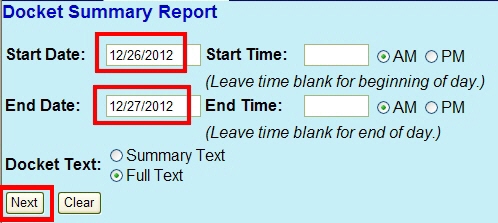
A report is displayed showing all the activity on the cases on which you are a party:
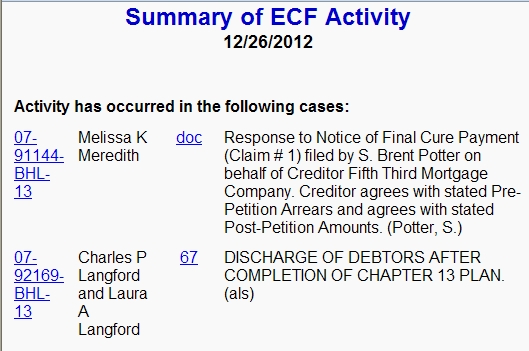
Viewing or obtaining copies of documents
Official Procedure Last Change March 23, 2022
Viewing or obtaining copies of documents on a case
General Information
- A copy of the discharge along with a list of the recipient list can be obtained here: https://ecf.insb.uscourts.gov/cgi-bin/autoInsbDischarge.pl
- Information on all cases filed on or after January 1, 1985 can be accessed via the PACER system. To view this information, you will need to register for a PACER user name and password. You will need to contact the appropriate divisional office to obtain information on cases filed before January 1, 1985, using the contact numbers as shown below.
- Individual documents filed on or after October 12, 2004 can also be accessed via the PACER system. (Documents filed between December 1st, 2003 and October 11, 2004 are also accessible for many Chapter 11, Chapter 12 and Chapter 7 Asset cases.) If the document number is underlined, this means that the document is available for viewing online, provided that no access restrictions apply. If the document number is not underlined, the document is not available for viewing online:
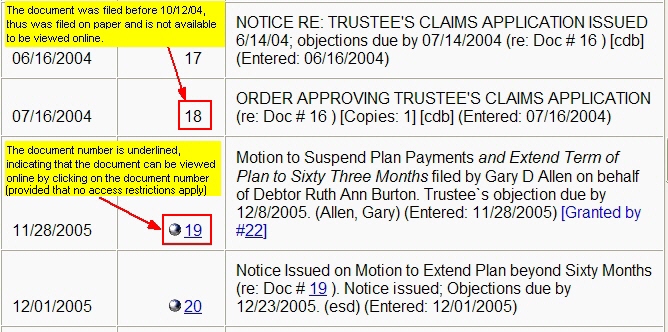
If a document is underlined but you are prevented from viewing it due to a security restriction, you may still be able to obtain a copy of the document. Contact the Clerk's Office for more information.
- If a case is still open, any paper documents that it contains (i.e. documents filed before 10/12/04) can be viewed at the appropriate divisional office.
- Shortly after a case containing paper documents is closed, it is shipped to the National Archives and Records Administration (NARA) located in Chicago, Illinois. Copies of paper documents in cases that have been shipped to the National Archives must be obtained directly from that facility. Note that documents in cases closed fifteen years or more ago may have been destroyed. Contact the National Archives for more information on such cases. For a smaller number of copies (typically about 100 pages or less), the SmartScan service is usually cheaper and faster.
- If a document does not display properly, try using another supported browser.
Viewing case information via PACER
- Log into PACER (Public Access to Court Electronic Records).
Note: If you do not have a PACER account, click here to register for one. You can also practice using the PACER training site, which allows you to become familiar with the service without incurring any fees.
- Click Query.
- Enter Social Security Number in the appropriate field. If you do not know that number, enter the first, middle and last name instead in the corresponding fields. Click Run Query.
- If only one case is found matching the information you entered, you are taken straight to that case. Otherwise, a list of all matching cases is displayed. Click on the desired case to view case information.
- Click Reports then Docket Report.
- Click Run Report.
- Scroll down through Docket Screen to view chronological list of documents filed in the case.
- Click on any underlined docket number to view that document.
To Order Copies from the National Archives
For requests for copies up to and including 100 pages, see separate instructions on the SmartScan service. For requests exceeding 100 pages:
- Contact the appropriate divisional office to obtain the transfer number and box number. (If the case has not yet been shipped to the National Archives, the divisional office will inform you.) You will need to provide the debtor's Social Security Number, case number or full name.
| Case number format | Divisional Office | Office Phone Number |
|
xx-0xxxx |
Indianapolis | (317) 229-3842 |
| xx-7xxxx | Evansville |
(812) 434-6481 |
| xx-8xxxx | Terre Haute |
(812) 434-6481 |
| xx-9xxxx | New Albany |
(812) 542-4552 |
- Call NARA to place your order at (773) 948-9030, or you can order online at https://eservices.archives.gov/orderonline. Alternatively, you can download and mail/fax the National Archives order form. (If using this form, leave the Location Number box blank.)
Viewing the docket of a case
Official Procedure Last Change September 18, 2018
Viewing the docket of a case
To view the docket of a case
- Log into CM/ECF.
- Click Reports > Docket Report.
- Enter the case number (in the format xx-xxxxx), select any desired options (see below), then click Run Report.
Note: Large dockets can take a while to load. You can speed up the process by excluding certain elements from the docket, particularly the following:
- Blue text at end of docket text
- Order icons next to document number
- Procedures links at end of docket text
The more elements you uncheck, the faster the docket will load. However, be aware of what you are unchecking in case it is an element you will need to see.
Options that are available
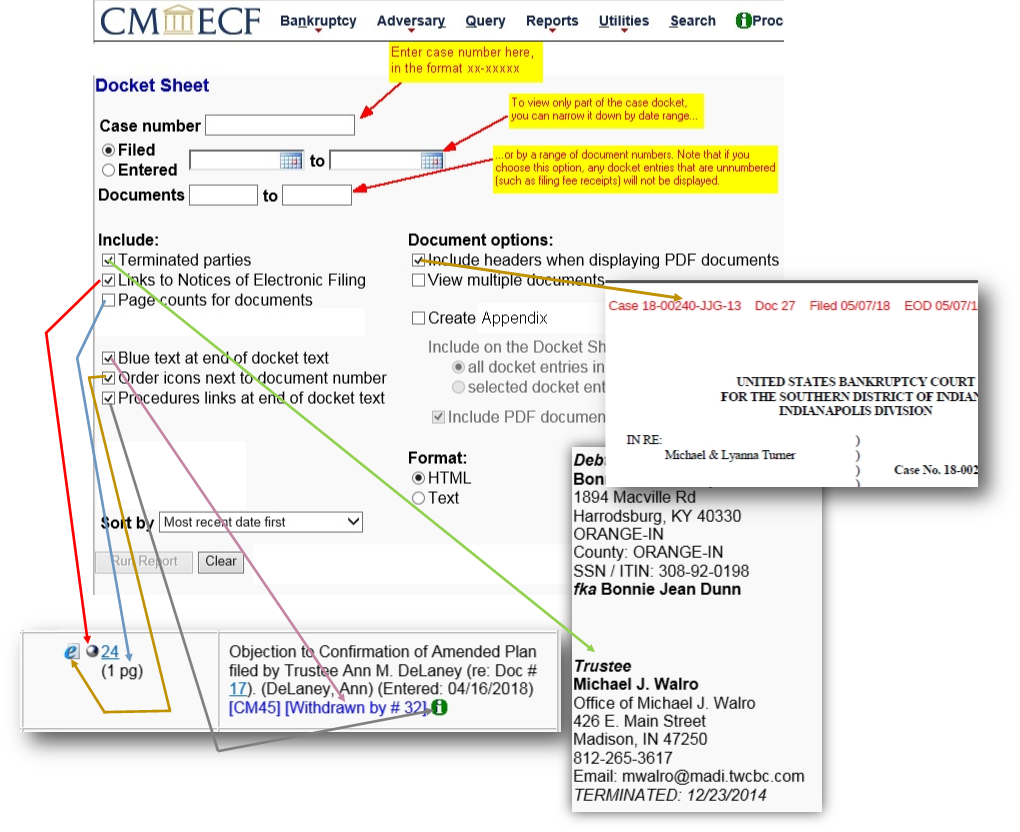
There is also the option to create a single PDF containing multiple documents (View multiple documents) and to include the docket or part thereof (Create Appendix).